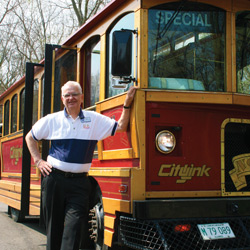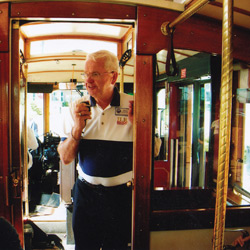
When it comes to tour guides, there are none better than those who can say, “I was there.”
Meet Kenny Carrigan. A delightfully young man of 76 years, Carrigan is a guide for the Peoria Historical Society’s trolley tours—and one of the area’s most colorful individuals. “There’s nothing normal about me,” he proclaims, before moving on to tell another fascinating story.
Outside of an Army stint during the Korean War, Carrigan has lived his entire life in Peoria, growing up on Hurlburt Street on the south side. He claims to have worked 27 different occupations in his life, ranging from errand boy to electrical construction.
To describe the man as an active civic volunteer barely does Kenny Carrigan justice. The grand marshal of the 2011 St. Patrick’s Day Parade, he is involved with the Saint Patrick Society of Peoria, Friends of Clonmel and Peoria Municipal Band, among others. He was instrumental in the formation of Illinois Central College in the 1960s, and has been active as a student, instructor and board member of the Osher Lifelong Learning Institute at Bradley University.
In addition to his affable personality, knowledge of local history and insatiable curiosity, two other qualities make Carrigan a masterful tour guide. First is his knack for storytelling. My prepared questions went out the window when we sat down to talk—I just sat back and listened. Secondly, he weaves a wealth of firsthand knowledge into his narrative. On the All-American City Tour, Carrigan chronicles Peoria’s history—“from the naughty to the nice”—and uses his experiences as a young boy to shine a fascinating light on a part of Peoria’s past that is often misunderstood.
Five Guys and a First Job
As a young boy at the tail end of the Depression, Carrigan got his start in the working world at the tender age of five, running errands for a local businessman. But this was no ordinary businessman. “Mayor Woodruff had five businessmen running gambling in the City of Peoria, and I went to work for one of the five guys,” he recalled. “That was my first job.”
“The Depression came to Peoria early—it didn’t start in ’29 here,” said Carrigan. Once known as the Whiskey Capital of World, Peoria had seen the golden years of its liquor industry end rather abruptly. “Prohibition started in 1920, and better than half of the people in Peoria were out of work.”
Mayor Edward Nelson Woodruff had served as Peoria’s mayor on and off since 1903, and was known for tolerating the city’s seedier side. Under Woodruff, Peoria was a “wide-open town.” He sanctioned the rough-and-tumble elements—namely, gambling and prostitution—because it meant badly-needed jobs and money for the city coffers. “Woodruff received so much for each slot machine and roulette wheel,” said Carrigan, “but he didn’t take any personally. That money went to the City of Peoria.”
Surviving the Depression
And so, for nearly a dozen years, Kenny Carrigan worked for one of Woodruff’s men. “I was the errand boy, I’d do anything,” he recalled. “I washed the windows, I cut the grass, I caddied. The men would shoot skeet, and I’d set the traps. And I got to ride in a big, black Cadillac all the time. [My family] didn’t have a car, so that was neat.”
And everywhere they went, there were slot machines. “You’d go to the grocery store, there were slot machines. You’d go into a drug store, there were slot machines. You’d go into a funeral parlor, there were slot machines.
“We didn’t twist any arms. We would go in and tell people, ‘We’ll put slots in your place. If it’s good, it’ll pay for your utilities. If it’s really good, it’ll pay your utilities and your rent.’ Many stores wouldn’t have survived the Depression without the income from those slot machines. That income is what kept the city solvent.”
But gambling was against state law. The state would occasionally attempt a crackdown, but Mayor Woodruff and his associates were always a step ahead. “We would know about 24 hours ahead of time when the state was going to raid the place,” said Carrigan. “That was a pretty harried time. They would send dump trucks out and put all the slot machines on the back.
“They’d clear them all out, but leave one for the state to find,” he chuckled. “And when they were gone, they’d go put them all back into operation again.”
Managing the Down Side
These men were not common criminals, nor gangsters. The mayor and these five businessmen cared very much about their River City. Understanding that there was a negative side to the gambling, they took steps to address those concerns.
“Let’s say I was coming home from work on a Friday night with my paycheck of $30, and I stopped at a gambling hall,” mused Carrigan, “and I was drinking and gambling and lost the money. When I arrived home and told my wife, she could go back to that gambling hall and tell them how much I lost, and they would give her 100 percent of the money back, right then and there. And then I would be barred from gambling in any gambling hall in Peoria for life.
“They were businessmen, and they knew that gambling could be an addiction,” he added. “That was their way of dealing with it. And that’s also why they told me, ‘Kenny, don’t ever gamble!’”
On one of his tours, Carrigan related this story, and a woman spoke up to confirm his account. “‘This happened to me once,’ she said. ‘My dad was barred from gambling, and he didn’t speak to my mother for six months!’”
A Big Game Dinner
Woodruff and his men also sought to mitigate the negative impact of these activities on Peoria’s religious community. “Some of the gamblers were also big hunters. And once a year, they would bring game in, and these five business guys would have a big dinner. They’d invite some of the area pastors and ask them where their budget was, how they were doing. And these were slim times.
“The following day—and I know this firsthand—we would take a paper grocery bag with a lot of cash in the bottom, and a couple loaves of bread sticking out of the top. And I was to take it in to the pastor. And so, they helped some churches out.
“They helped out more than one business as well. A lot of small companies couldn’t get money from the banks at the time, and they loaned money to them at very reasonable rates.
“They were businessmen,” Carrigan added, “and they took a common-sense approach. They didn’t want to tear the community down.”
Reform Comes to Town
“The gambling was shut down after World War II because a bad element had come in,” explained Carrigan. This was the infamous Shelton gang—“America’s bloodiest,” said the Saturday Evening Post in 1950—led by brothers Carl, Earl and Bernie. “There were very few people killed during 13 years of Prohibition. But when the Sheltons came in, that was a different story.”
By 1945, Peorians, who had tired of the lawlessness, elected a reform candidate, Carl Triebel, as mayor. While vice was not eradicated, it was the end of the Woodruff era, and the end of Peoria as a “wide-open town.”
Many people are uncomfortable talking about these elements of Peoria’s past. Some would like to forget that it ever happened. Others romanticize the gangster elements, which can lead to some pretty tall tales. But it’s not unfair to suggest that this town was built on booze and gambling, at least in part. And while that should not be glamorized, to not acknowledge it at all smacks of historical revisionism. Ask Kenny…
Ask Kenny…
Carrigan has narrated trolley tours for the Peoria Historical Society for about a decade and a half. “And it’s different every time!” he exclaims. “When you talk about some of these things, it jars [people’s] memories. This is a part of our history, and it’s immediate! It is not something in theory, it is not something in another world—it’s right here.”
He enjoys the mix of locals and out-of-towners on these tours because they ask very different questions. “And I learn from every tour,” he says. “People know a lot of things that I don’t. I tell people, if you’ve gone on one of these tours before, come again, and you’ll hear something completely different.”
Working without a script, Carrigan jumps excitedly from one subject to the next, swimming in his own unique stream of consciousness. His knowledge of Peoria-area history spans far and wide, and his curiosity is insatiable. When we got together, our conversation jumped from Mayor Woodruff to Chief Gomo, from Black Partridge to Joseph Petarde, from ethanol to city politics to passenger trains.
In a Journal Star feature last year, Carrigan cited his favorite period of Peoria’s history as “1192 through 2010.” This was not a typo, he says—he loves every minute of it. The 1192 date derives from an archaeological dig near Spring Bay in which he once participated—“that was the date given to a number of old Peoria Indian artifacts that were dug up.”
How did the telegram system used to work in Peoria’s downtown hotels? Ask Kenny Carrigan—he was there. What’s a punchboard? Ask Kenny Carrigan—he may even show you the genuine article. Why did some distillery workers keep straws in their pockets? Ask Kenny Carrigan—“I was in the rackhouses, and I saw it!” iBi

